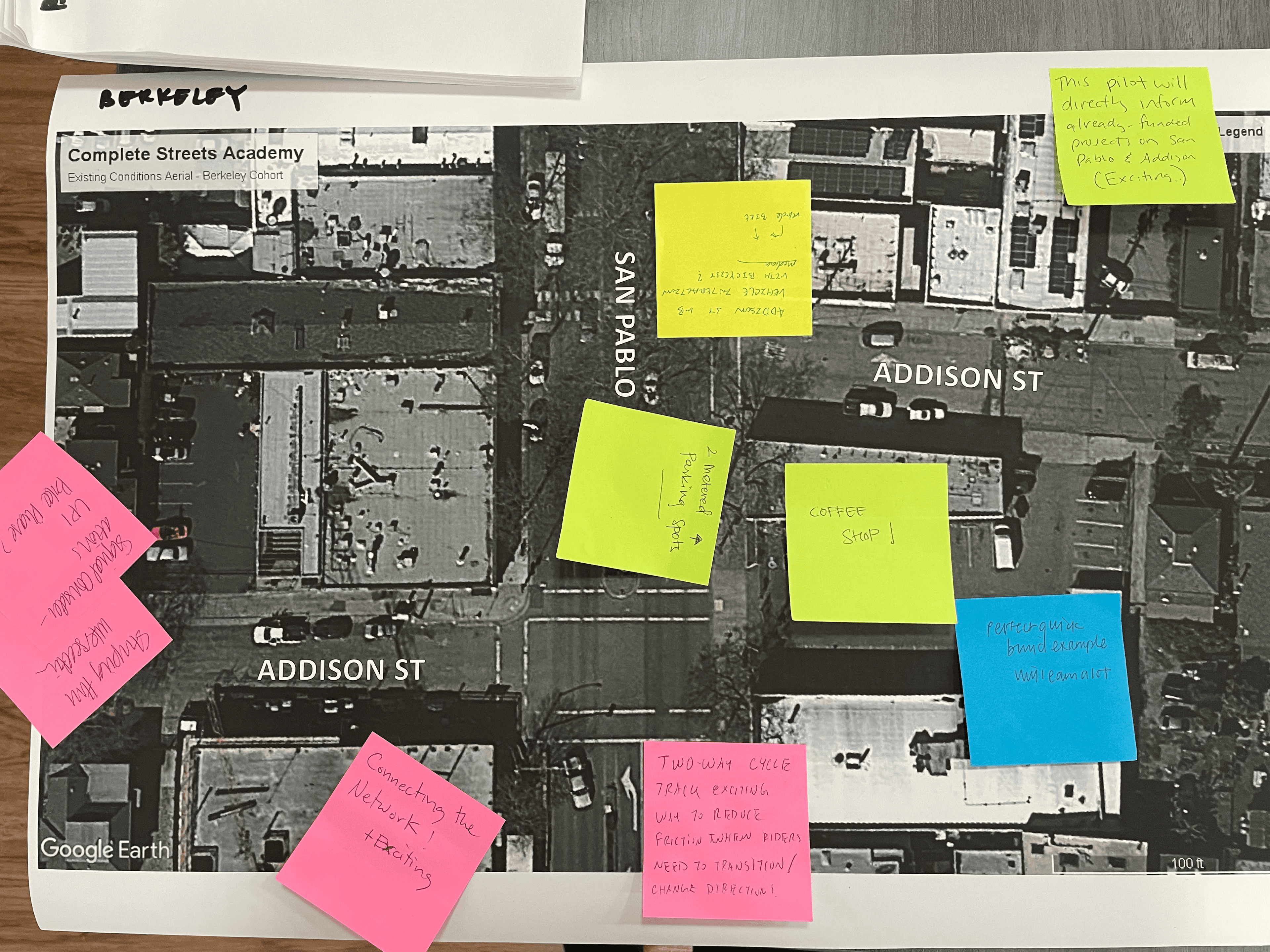
News
By Eric Cova, March 20, 2024
The City of Berkeley’s vision was to test an unconventional design to improve safety for cyclists navigating a non-linear intersection on San Pablo Avenue. Ultimately the project was not installed due to various capacity constraints, but nevertheless, going through the design iteration process within their team, discussing permitting with Caltrans, exploring contractor support options, and conducting community engagement with adjacent businesses left the city valuable insights they will be able to leverage in the future. Read the full case study in the Complete Streets Leadership Academies Report and explore the other case studies here.
Failure to Implement
Throughout the program, Berkeley experienced staff turnover and capacity challenges. With limited staff time available to be fully dedicated to this project and competing priorities, the city would’ve needed to rely on an outside contractor to complete the project, incurring additional costs. Due to these challenges, the city withdrew from the academy before the project could be installed. Even so, the city was able to make some progress on safe streets, charting out its community engagement plan and beginning initial engagement.
Though Berkeley was ultimately unable to see their quick-build demonstration come to fruition, plans are in the works for the corridor informed by their Complete Streets Leadership Academy experience. In November 2023, the Berkeley City Council considered and approved two conceptual designs for the Alameda County Transportation Commission (ATC) to explore with CalTrans: their preferred option of a one-way cycle track on each side of the street and a fallback option that includes a two-way cycle track on the east side. Whichever design is chosen, the ATC will be constructing the project simultaneously with other Safety Enhancement Projects on San Pablo Avenue, expected in the spring of 2025.
Proposed Project Concept
The project goal was to test a design solution for a bike boulevard crossing on San Pablo Avenue at the selected intersection. Initially, the city started with the idea of a conventional configuration of adding a one-way cycle track on each side of San Pablo Avenue but faced pushback from adjacent businesses about parking impacts. This combined with cost concerns and cumbersome Caltrans permitting procedures related to signal timing modifications. This pushed the city to explore an alternate configuration of a two-way cycle track on one side of the street. Now, the city envisions a potential permanent project similar to the original one-way cycle track at street level on each side of San Pablo Avenue.
Key Takeaways
Identify potential issues and obstacles early on in the process and communicate them to partners. While it is inevitable that some unexpected issues will arise throughout the process, things like competing priorities and staffing challenges can and should be considered in the early stages of planning. Doing so allows for improved coordination to resolve these issues and the potential of getting support from partners.
Despite a failure to implement the project, lessons can still be taken from the process. The main goal of a quick build is to test new and creative ideas to better understand the project implementation process. While this project didn’t move from paper to pavement, developing the quick build for several months allowed city staff to build a greater understanding of the two-way cycle track option, making it a competitive alternative for a permanent project in the future.
Open communication allows agencies to build trust and opens the door for creative and alternative solutions. Upon understanding that the temporary project was intended for the summer months when the region does not expect heavy rainfall, Caltrans was able to waive a required hydrology review. By building upon this partnership in future projects, the city and Caltrans are both better prepared to utilize similar flexibility in the future.
 In 2022, Smart Growth America launched the Complete Streets Leadership Academies in Alaska, California, Connecticut, and Tennessee to equip and train local agencies and state departments of transportation to collaborate, innovate, and commit to making changes together to address safety on these dangerous state-owned roads. Cohorts were selected to plan and implement “quick-build” demonstration projects, a way to pilot and test new ideas and street designs to activate streets and better support walking, biking, and rolling.
In 2022, Smart Growth America launched the Complete Streets Leadership Academies in Alaska, California, Connecticut, and Tennessee to equip and train local agencies and state departments of transportation to collaborate, innovate, and commit to making changes together to address safety on these dangerous state-owned roads. Cohorts were selected to plan and implement “quick-build” demonstration projects, a way to pilot and test new ideas and street designs to activate streets and better support walking, biking, and rolling.This program and report was developed with funding from the Centers for Disease Control and Prevention’s (CDC) Division of Nutrition, Physical Activity, and Obesity (Cooperative Agreement CDC-RFA-OT18-1802). The views presented in this product do not necessarily reflect the views and/or positions of CDC.
Related News

© 2025 Smart Growth America. All rights reserved
Site By3Lane Marketing




























